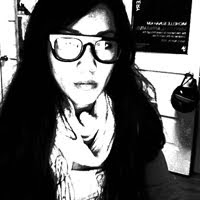Sunday, January 31, 2010
TOMORROW, IN A YEAR... IN A NIGHT
† I don't know if it just happened to be coincidence but prior to my trip I had become obsessed with the BBC Planet Earth series. Not strange at all since I believe anyone that has seen even one of them knows how easy it is to get hooked on the wonderment of seeing the vast, seemingly untouched, natural world in HD. It's also hard to think that none of us will ever see even a fraction of this kind of nature up close, in person, for as long as we are alive.
Charles Darwin, however, must have been close. Prior to publishing Origin of the Species, the gestation period of his research was in excess of 20 some odd years. The Knife's electro opera celebrating the 150 years since the publication of the Origin of the Species was indeed an appropriate celebratory performance done through the means of post-modern dance and minimalistic staging.
At first I was a bit underwhelmed. I figured that with so much buzz around "The Knife Opera" and with Olof Dreijer attending an Amazon rainforest recording workshop and all, that they would have gone balls out. I had seen Karin Dreijer Andersson, also known as Fever Ray, perform recently at the Regency Ballroom in SF, and I was blown away by the elaborate staging. So naturally, I expected the opera to be ten times more elaborate and visually stimulating, especially with the help of two collaborators, Mt. Sims and Planningtorock. Perhaps it is just their continued secrecy and policy to never tour that also had me in high hopes.
Dansen Hus is a very intimate venue. Just about the size of a large school play auditorium. I was excited that I would be able to experience this from up very close (I was in the 10throw and somewhat near the middle). I took my seat and the show began. If you’ve listened to the full album that was released just recently, you’ll notice that it is incredibly slow. I had not been able to hear the full album prior to seeing the show so it was a bit unexpected. That was where I was underwhelmed.I kept waiting for more “sing-songy”, Knife-like riffs but I realized that I had to wait. After waiting a while, I realized that the purpose of their slow start off was to demonstrate the slow formation of the earth. The dancer’s movements were subtle to mimic the slow and steady processes of evolution. There was a small blonde dancer whose movements reminded me of the way the jungle creatures jerk and tick around in planet earth. At some point the main stage platform split open and the stage, which also represented a brick wall and I believe also the HMS Beagle, which Darwin was aboard during his research. It was exposed from the inside so that one could see all the neat rows of crazy LED lights. I did actually enjoy the deconstruction of the stage. To me it represented the moment of Darwin’s theory fully realized. Towards the end of the opera, the wait for the more Knife-esque songs were well worth it. They seemed obviously different and a bit unsure (in a good way) than their usual dark electro pop songs.
Olof Dreijer says: “At first it was very difficult as we really didn’t know anything about opera. We’d never been to one. I didn’t even know what the word libretto meant. But after some studying, and just getting used to opera’s essence of pretentious and dramatic gestures, I found that there is a lot to learn and play with. In fact, our ignorance gave us a positive respect-less approach to making opera. It took me about a year to become emotionally moved by an opera singer and now I really do. I really like the basic theatrical values of opera and the easy way it brings forward a narrative. We’ve approached this before in The Knife but never in such a clear way.”
I left the opera not feeling underwhelmed like the way I came in. As the opera went on, my slight feelings of disappointment were transformed into feelings of satisfaction and enjoyment.The vocals of Jonathan Johansson were otherworldly, as were the tones of mezzo-soprano,Kristina Wahlin Mommes harmonizing with actress Laerke Winther. The dancers were able to transform themselves into moving caricatures of evolving animals without the aid of elaborate costumes. Although the studio version my not translate as well as far as “listenability goes” the opera, combining both the audio and visual aspects, truly shows the versatile nature of this ever-changing Swedish duo.
Subscribe to:
Post Comments (Atom)






No comments:
Post a Comment